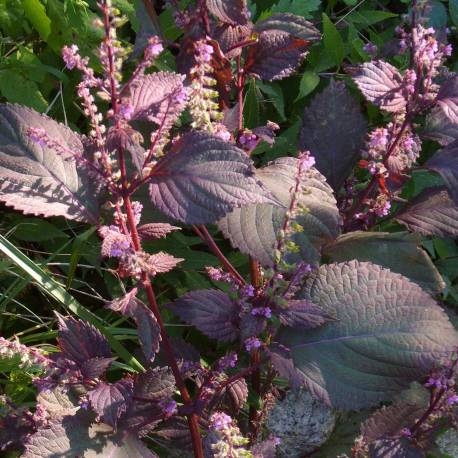No products
Product successfully added to your shopping cart
There are 0 items in your cart. There is 1 item in your cart.
Perilla frutescens 'Purpurea' sin. 'Akashiso'
Un Quadrato di Giardino - Podenzano (PC)Perilla frutescens
New
Perilla purpurea is an invasive plant whose seeds do not fear frost. It has large and unusual leaves, very ornamental, of an intense metallic color with purple-purple tones.
Parte di pianta da usare in cucina : fiori e foglie
La pianta è in vaso di 14-16 cm di diametro
10 Items
Perilla purpurea is an invasive plant whose seeds do not fear frost. It has large and unusual leaves, very ornamental, of an intense metallic color with purple-purple tones.
Suitable in mixed borders as a background or backdrop plant, and also in pots, where the incredible foliage will be enhanced. It requires little care. It self-sows, which is why you must remember to always leave some flowers unflowered; it can be invasive, but the excess young plants are eliminated very easily only at the beginning of the season, once a year.
Classification
Common name: Chinese or Japanese basil, Korean perilla, Beefsteak plan, Shiso or Egoma in the countries of origin.
Genus and species: Perilla frutescens
Cultivar: 'Purpurea' or 'Akashiso'
Family: Lamiaceae.
Characteristics
Description of flowers: In erect spikes.
Flower color: Lilac-pink.
Flowering period: Autumn.
Leaves: Purple, metallic and hairy, with serrated edges.
Fragrance: The leaves smell sweetly, with spicy notes.
Dimensions: Height up to 1.20 m, takes the shape of a shrub.
Cultivation
Irrigation: Loves water, if grown in the sun. It does not need regular watering, but only when necessary if grown in the shade.
Frost resistance: the seeds certainly resist USDA 7a, but perhaps also more intense frost.
Care
Pruning: It can be cut and trimmed at the beginning of summer to make it branch. When frost arrives, if you remove the dry matter, remember to shake the heads of the seeds, so that the latter are distributed on the surface.
Propagation: By division at the end of winter or by sowing in spring after the frosts have passed; from cuttings in late spring/summer.
Notes of interest
Use in the kitchen: Not to be harvested when in seed, it can be served raw or cooked; very suitable in salads and perfect for flavoring risottos and desserts, excellent fried in batter. Its flavor is a combination of curry, cumin, coriander, and parsley with a hint of cinnamon.
Herbal properties: Rich in flavonoids and omega3, it is an excellent anti-inflammatory and anti-allergic.











